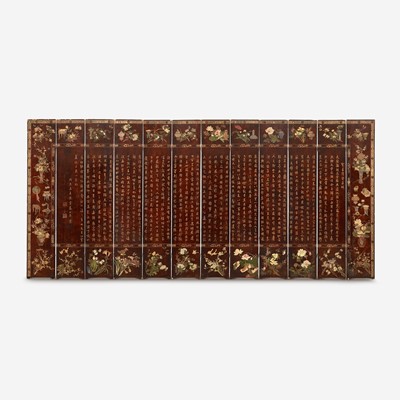April 8, 2021 10:00 EST
Asian Arts
81
A Chinese carved twelve-panel "Coromandel" folding screen
17th/18th Century
Finely carved and colored with numerous figures and immortals arriving to celebrate before an Emperor, among pavilions, gates, rockwork and lush vegetation, the upper panels depicting landscapes and bird and flowers, lower panels with animals, mythical and mundane, the side panels with additional auspicious beasts below sinuous dragons descending though scrolling clouds; the reverse with a lengthy calligraphic inscription with a transcription of Shengzhu de Xianchen song, which may be translated as "Ode to the Lord Who Has a Virtuous Minister/Subject," composed by Wang Bao of the Western Han dynasty. Further inscribed "Written by Marquis Gao Shinian in the first month of summer in the wu chen year (possibly equivalent to 1688). Two seals of the calligrapher Gao Shinian(?), and Si Yi(?); all bordered by reserves of flowers and antiques.
H: 103 1/2, W: 18 1/2 in. (each panel)
Provenance: Private collection, New York, acquired prior to 1995
thence by descent to the present owner
NOTE: The calligrapher Gao Shinian has been recorded as a scholar-official from Fujian.
Such screens were at the height of popularity in China in the late 17th and early 18th century, particularly as high level gifts to commemorate important occasions or birthdays. These screens were also exported to the west, where they were used to panel interiors, such as those now in the Rijksmuseum, Amsterdam, which were known to have paneled a "Chinese Room" in Leeuwarden between 1694-1696, illustrated in W. De Kesel and G. Dhont, "Coromandel Lacquer Screens", Gent, nd, p. 24-25, or, during the ancien regime in France, such screens were disassembled and used to create fine furniture such as commodes and secretaires.
For screens dating to the Kangxi period, with similar auspicious beasts in lower panels and dragon side panels, see ibid pp. 23, 25, 56-57, 71, 82, ill 14, 15 (also with similar flower sprays and antiques to the present screen verso) ill, 16, 37, 47, 54.
Sold for $85,050
Estimated at $20,000 - $30,000
Finely carved and colored with numerous figures and immortals arriving to celebrate before an Emperor, among pavilions, gates, rockwork and lush vegetation, the upper panels depicting landscapes and bird and flowers, lower panels with animals, mythical and mundane, the side panels with additional auspicious beasts below sinuous dragons descending though scrolling clouds; the reverse with a lengthy calligraphic inscription with a transcription of Shengzhu de Xianchen song, which may be translated as "Ode to the Lord Who Has a Virtuous Minister/Subject," composed by Wang Bao of the Western Han dynasty. Further inscribed "Written by Marquis Gao Shinian in the first month of summer in the wu chen year (possibly equivalent to 1688). Two seals of the calligrapher Gao Shinian(?), and Si Yi(?); all bordered by reserves of flowers and antiques.
Provenance: Private collection, New York, acquired prior to 1995
thence by descent to the present owner
NOTE: The calligrapher Gao Shinian has been recorded as a scholar-official from Fujian.
Such screens were at the height of popularity in China in the late 17th and early 18th century, particularly as high level gifts to commemorate important occasions or birthdays. These screens were also exported to the west, where they were used to panel interiors, such as those now in the Rijksmuseum, Amsterdam, which were known to have paneled a "Chinese Room" in Leeuwarden between 1694-1696, illustrated in W. De Kesel and G. Dhont, "Coromandel Lacquer Screens", Gent, nd, p. 24-25, or, during the ancien regime in France, such screens were disassembled and used to create fine furniture such as commodes and secretaires.
For screens dating to the Kangxi period, with similar auspicious beasts in lower panels and dragon side panels, see ibid pp. 23, 25, 56-57, 71, 82, ill 14, 15 (also with similar flower sprays and antiques to the present screen verso) ill, 16, 37, 47, 54.









